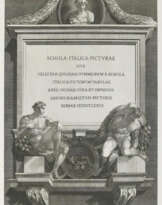ID 1108825
Lot 26 | [Michelangelo Buonarroti (1475-1564)] – Antonio Mini (c.1507-1533)
Estimate value
£ 30 000 – 50 000
Autograph letter signed (‘Antonio Mini’) to Michelangelo Buonarroti (‘Michelangniolo Buonaroti’), Lyons, 27 February 1531/2
In vernacular Italian. 2¼ pages, 281 x 204mm, bifolium, integral autograph address panel (‘Insigni viro domino Michelangniolo Buonaroti in Firenze, o vero dove si trova a cierto [or find out where he is]’, the address leaf preserving seal and paper tie, dispatch slits. Provenance: Sotheby’s, 18 May 1995, lot 42.
A high-spirited, affectionate letter to Michelangelo Buonarroti from his apprentice Antonio Mini in Lyons: confidently reporting on his efforts to win the patronage of Francis I, asking for a cartoon of Leda and the Swan coloured by Pontormo, boasting of a new velvet doublet and mentioning Michelangelo’s work on the tomb of Pope Julius II. Mini mentions a letter sent to Michelangelo by [?Giovanni della] Spina, before updating his master on his progress abroad: ‘I mean to catch that hare myself, but you know there are a great many dogs who would like to catch it themselves and would like to make themselves out to be fine fellows in their own field and to show the King the great devotion they have borne him – the King – through the exertions of others. But you know they have made a mistake, because I am standing firm, like a strong wall, and have here such support that I could pluck it [i.e. the hare] from the stars. I need only say the least little word’. Mini asks for permission to have delivered to Lyons through the agency of ‘Girolamo’ Gondi the cartoon [of Leda], drawn by Michelangelo and coloured by Pontormo: ‘my dear Michelangelo, please consent if anyone tries to get in my way, to help me, as you have always done, without putting yourself to any inconvenience. For you know that if you tell me to fly low, if I do not want to break my neck, I make reply that I want to do as you tell me. You know that I want to go to see the King, having good grounds to do so, as we have already given an account of ourselves and of the work we have done and are doing’; he is making good progress on a large picture and intends to stay longer in Lyons to remain close to the court, reporting happily on the health of his finances and those of his partner: ‘Just think, I have had a doublet made in velvet […] and as to my companion, because he has painted a portrait of Francesco, he [Francis I] has given him an entirely new set of clothes and does not wish him to know what it cost’. Mini continues in ebullient form – ‘I must tell you that men make headway living away from home’ – offering to sponsor Michelangelo’s nephew should he come to join him, noting that he would find many other Florentines there, and making reference to Pope [Julius II] sending for Michelangelo [about the commission for his tomb]: ‘May it please God that for the rest you may be able to repose a little with a quiet mind […] for I know for how long you have been troubled’ [translation].
Antonio Mini entered Michelangelo’s service as a teenager in 1523 and soon became a favoured pupil and sometime-proxy in business matters, in spite of early chiding from his master about his work ethic (a c.1524 study in the British Museum [1859,0514.818] bears a note from Michelangelo to his apprentice instructing him to ‘draw Antonio, draw and do not waste time’). His move to Lyons, to the court of the French king Francis I, was prompted by his need to provide dowries for his sisters, towards which end he spent much of his time executing copies of Michelangelo's Leda and the Swan, the (now-lost) painting bequeathed to him by his master, which he had brought to France. Their affectionate relationship endured across the years: Mini commands Michelangelo at the end of the present letter to ‘remember that if it were possible you have more than a son’, signing himself ‘Your affectionate Antonio Mini in Lyons, who through you is alive, well and happy’. In spite of his optimism about his situation in Lyons, Mini would die the following year, without seeing his thirties and evidently without winning the patronage of the king.
Published: Barocchi and Ristori (eds.), Il carteggio di Michelangelo, vol. III (Florence: Sansone Editore, 1973), p. 377ff.
| Artist: | Michelangelo Buonarroti (1475 - 1564) |
|---|---|
| Place of origin: | France, Italy |
| Auction house category: | Letters, documents and manuscripts |
| Artist: | Michelangelo Buonarroti (1475 - 1564) |
|---|---|
| Place of origin: | France, Italy |
| Auction house category: | Letters, documents and manuscripts |
| Address of auction |
CHRISTIE'S 8 King Street, St. James's SW1Y 6QT London United Kingdom | |||||
|---|---|---|---|---|---|---|
| Preview |
| |||||
| Phone | +44 (0)20 7839 9060 | |||||
| Buyer Premium | see on Website | |||||
| Conditions of purchase | Conditions of purchase |
![[Michelangelo Buonarroti (1475-1564)] – Antonio Mini (c.1507-1533) - photo 1 [Michelangelo Buonarroti (1475-1564)] – Antonio Mini (c.1507-1533) - photo 1](/assets/image/picture_3643718/68976/nl9xsrcvovflaeh9swxxorwntmuftweds9hqbn-5zumigwexym0lzmdbzvjyyk1701504448jpg__fix_555_460.jpeg)
![[Michelangelo Buonarroti (1475-1564)] – Antonio Mini (c.1507-1533) - photo 2 [Michelangelo Buonarroti (1475-1564)] – Antonio Mini (c.1507-1533) - photo 2](/assets/image/picture_3643719/c25f2/lwvzhfhswfryg02grxct7kmbilafrnbiyvb7usbaqplj4htijxu60ixexizoel1701504448jpg__fix_555_460.jpeg)
![[Michelangelo Buonarroti (1475-1564)] – Antonio Mini (c.1507-1533) - photo 3 [Michelangelo Buonarroti (1475-1564)] – Antonio Mini (c.1507-1533) - photo 3](/assets/image/picture_3643720/7fe73/bhurj99dpf564bdurusmropkbximxo74sktbt7jvhcbsptiyi4q-pkirhsjvz2c1701504448jpg__fix_555_460.jpeg)





![[Michelangelo Buonarroti (1475-1564)] – Antonio Mini (c.1507-1533) - photo 1 [Michelangelo Buonarroti (1475-1564)] – Antonio Mini (c.1507-1533) - photo 1](/cache/lot/1108825/NL_9XsrCVoVFLaeH9SwxxORwNTMUfTweDS9hQbn-5zuMiGWEx_yM0lzmDbzvJYyK_1701504448-80x80_center_50.jpg)
